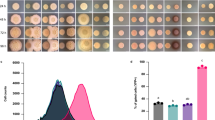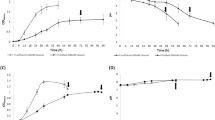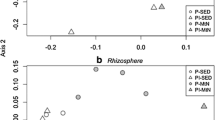Abstract
Pseudomonas protegens synthesizes two major iron-chelating metabolites (siderophores): pyoverdine (Pvd) and enantio-pyochelin (E-Pch). Although iron sequestration and uptake seem to be the main biological role of these siderophores, other functions including metal homeostasis and antibiotic activity have been proposed. The aim of this study was to evaluate the contribution of Pvd and E-Pch to the survival of P. protegens in soil using wild type and isogenic mutant strains unable to produce Pvd, E-Pch or both siderophores. Survival of these strains in sterile soil microcosms, in soil microcosms containing the native microflora and in sterile soil microcosms containing fusaric acid (a mycotoxin able to chelate iron and other metals), was compared by determination of colony forming units (CFU) per gram dry soil over time. In sterile soil, cell densities of Pvd-producing strains were significantly higher than that of non-producers after 21 days of permanence in the microcosms. In non-sterile soil, viability of all strains declined faster than in sterile soil and Pvd producers showed higher CFU × (g dry weight soil)−1 values than non-producers. The presence of fusaric acid negatively affected viability of strains unable to produce Pvd, while had no effect on the viability of strains able to produce Pvd. Altogether, these results show that the ability to produce Pvd increases survival of P. protegens in soil, while the ability to synthesize E-Pch does not, indicating that under the conditions which prevail in soil, iron scavenging via Pvd is more beneficial than via E-Pch.



Similar content being viewed by others
References
Adler C, Corbalan NS, Seyedsayamdost MR, Pomares MF, de Cristobal RE, Clardy J, Kolter R, Vincent PA (2012) Catecholate siderophores protect bacteria from pyochelin toxicity. PLoS ONE 7(10):e46754
Andrews SC, Robinson AK, Rodriguez-Quinones F (2003) Bacterial iron homeostasis. FEMS Microbiol Rev 27(2–3):215–237
Bacon CW, Hinton DM, Hinton A Jr (2006) Growth-inhibiting effects of concentrations of fusaric acid on the growth of Bacillus mojavensis and other biocontrol Bacillus species. J Appl Microbiol 100(1):185–194
Boyer HW, Roulland-Dussoix D (1969) A complementation analysis of the restriction and modification of DNA in Escherichia coli. J Mol Biol 41(3):459–472
Brown DW, Lee SH, Kim LH, Ryu JG, Lee S, Seo Y, Kim YH, Busman M, Yun SH, Proctor RH, Lee T (2015) Identification of a 12-gene fusaric acid biosynthetic gene cluster in Fusarium species through comparative and functional genomics. Mol Plant Microbe Interact 28(3):319–332
Budzikiewicz H (2004) Siderophores of the Pseudomonadaceae sensu stricto (fluorescent and non-fluorescent Pseudomonas spp.). Fortschr Chem Org Naturst 87:81–237
Cox CD, Rinehart KL Jr, Moore ML, Cook JC Jr (1981) Pyochelin: novel structure of an iron-chelating growth promoter for Pseudomonas aeruginosa. Proc Natl Acad Sci USA 78(7):4256–4260
Dumas Z, Ross-Gillespie A, Kummerli R (2013) Switching between apparently redundant iron-uptake mechanisms benefits bacteria in changeable environments. Proc Biol Sci 280(1764):20131055
Haas D, Defago G (2005) Biological control of soil-borne pathogens by fluorescent pseudomonads. Nat Rev Microbiol 3(4):307–319
Herrero M, de Lorenzo V, Timmis KN (1990) Transposon vectors containing non-antibiotic resistance selection markers for cloning and stable chromosomal insertion of foreign genes in gram-negative bacteria. J Bacteriol 172(11):6557–6567
Howell CR, Stipanovic RD (1979) Control of Rhizoctonia solani on cotton seedlings with Pseudomonas fluorescens and with an antibiotic produced by the bacterium. Phytopathology 69:480–482
Kessler B, de Lorenzo V, Timmis KN (1992) A general system to integrate lacZ fusions into the chromosomes of gram-negative eubacteria: regulation of the Pm promoter of the TOL plasmid studied with all controlling elements in monocopy. Mol Gen Genet: MGG 233(1–2):293–301
King EO, Ward MK, Raney DE (1954) Two simple media for the demonstration of pyocyanin and fluorescin. J Lab Clin Med 44(2):301–307
Lindsay WL, Norvell WA (1978) Development of a DTPA soil test for zinc, iron, manganese, and copper. Soil Sci Soc Am J 42:421–428
Loper JE, Kobayashi DY, Paulsen IT (2007) The genomic sequence of Pseudomonas fluorescens Pf-5: insights into biological control. Phytopathology 97(2):233–238
López NI, Ruiz JA, Méndez BS (1998) Survival of poly-3-hydroxybutyrate-producing bacteria in soil microcosms. World J Microbiol Biotechnol 14:681–684
Lowbury EJ (1951) Improved culture methods for the detection of Ps. pyocyanea. J Clin Pathol 4(1):66–72
Malini S (1966) Heavy metal chelates of fusaric acid: in vitro spectrophotometry. J Phytopathol 57(3):221–231
Martinez-Garcia E, Aparicio T, de Lorenzo V, Nikel PI (2014) New transposon tools tailored for metabolic engineering of gram-negative microbial cell factories. Front Bioeng Biotechnol 2:46
Meyer JM, Abdallah MA (1978) The fluorescent pigment of Pseudomonas fluorescens: biosynthesis, purification and physicochemical properties. J Gen Microbiol 107:319–328
Michavila G, Adler C, De Gregorio PR, Lami MJ, Caram Di Santo MC, Zenoff AM, de Cristobal RE, Vincent PA (2017) Pseudomonas protegens CS1 from the lemon phyllosphere as a candidate for citrus canker biocontrol agent. Plant Biol (Stuttg) 19(4):608–617
Mirleau P, Delorme S, Philippot L, Meyer J, Mazurier S, Lemanceau P (2000) Fitness in soil and rhizosphere of Pseudomonas fluorescens C7R12 compared with a C7R12 mutant affected in pyoverdine synthesis and uptake. FEMS Microbiol Ecol 34(1):35–44
Nelson DW, Sommers E (1982) Total carbon, organic carbon and organic matter. In: Page AL (ed) Methods of soil analysis, part 2, 2nd edn, vol 9. American Society of Agronomy, Madison, pp 534–579
Phoebe CH Jr, Combie J, Albert FG, Van Tran K, Cabrera J, Correira HJ, Guo Y, Lindermuth J, Rauert N, Galbraith W, Selitrennikoff CP (2001) Extremophilic organisms as and unexplored source fo antifungal compounds. J Antibiot (Tokyo) 54(1):56–65
Ruiz JA, Bernar EM, Jung K (2015) Production of siderophores increases resistance to fusaric acid in Pseudomonas protegens Pf-5. PLoS ONE 10(1):e0117040
Schalk IJ, Hannauer M, Braud A (2011) New roles for bacterial siderophores in metal transport and tolerance. Environ Microbiol 13(11):2844–2854
. Sun GX, Zhou WQ, Zhong JJ (2006) Organotin decomposition by pyochelin, secreted by Pseudomonas aeruginosa even in an iron-sufficient environment. Appl Environ Microbiol 72(9):6411–6413
Vasil ML, Ochsner UA (1999) The response of Pseudomonas aeruginosa to iron: genetics, biochemistry and virulence. Mol Microbiol 34(3):399–413
Verhagen BW, Trotel-Aziz P, Couderchet M, Hofte M, Aziz A (2010) Pseudomonas spp.-induced systemic resistance to Botrytis cinerea is associated with induction and priming of defence responses in grapevine. J Exp Bot 61(1):249–260
Wendenbaum S, Demange P, Dell A, Meyer JM, Abdallah MA (1983) The structure of pyoverdine Pa, the siderophore of Pseudomonas aeruginosa. Tetrahedron Lett 24(44):4877–4880
Youard ZA, Mislin GL, Majcherczyk PA, Schalk IJ, Reimmann C (2007) Pseudomonas fluorescens CHA0 produces enantio-pyochelin, the optical antipode of the Pseudomonas aeruginosa siderophore pyochelin. J Biol Chem 282(49):35546–35553
Youard ZA, Wenner N, Reimmann C (2011) Iron acquisition with the natural siderophore enantiomers pyochelin and enantio-pyochelin in Pseudomonas species. Biometals 24(3):513–522
Acknowledgements
This work was supported by Grants from Buenos Aires University, Argentina (UBACyT 20020130200117BA) and the Alexander von Humboldt Foundation, Germany (Grant equipment to JAR).
Author information
Authors and Affiliations
Corresponding author
Ethics declarations
Conflict of interest
The authors declare that they have no conflict of interest.
Rights and permissions
About this article
Cite this article
Drehe, I., Simonetti, E. & Ruiz, J.A. Contribution of the Siderophores Pyoverdine and Enantio-Pyochelin to Fitness in Soil of Pseudomonas protegens Pf-5. Curr Microbiol 75, 1560–1565 (2018). https://doi.org/10.1007/s00284-018-1560-7
Received:
Accepted:
Published:
Issue Date:
DOI: https://doi.org/10.1007/s00284-018-1560-7




